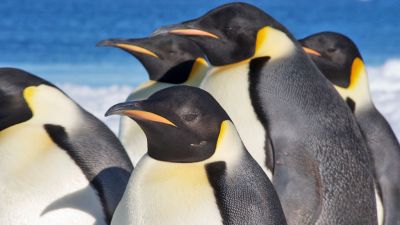
Return to the Penguins
In December 2012, a team from Princess Elisabeth Antarctica made history - and caused a worldwide media frenzy - by becoming the first humans to make contact with a 9,000 strong emperor penguin colony on Antarctica’s Princess Ragnhild Coast.
During a recent scientific trip from Princess Elisabeth Antarctica to the coast of Antarctica, Alain Hubert and Christophe Berclaz took a few hours to revisit the colony. It was an emotional return for Alain Hubert, who was one of the first humans to see the colony. Researchers from the British Antarctic Survey first discovered the colony of 1m-tall emperor penguins using satellite imagery. Their findings, and the locations of several populations was published in a 2009 paper by Peter T. Fretwell and Philip N. Trathan, “Penguins from space: faecal stains reveal the location of emperor penguin colonies”. However, the colony’s existence was unconfirmed until an International Polar Foundation team from Princess Elisabeth Antarctica visited the colony in early December 2012.
We didn't count the penguins precisely, but you can roughly estimate the total number of birds in the colony by looking at the number of chicks. It is easier to count the chicks because adults move around to go fishing. Since each couple of penguins only has one chick per year, multiplying the number of chicks by three gives you a good minimal estimate of the total number of penguins in the colony. We estimate there are 15,000 individual penguins, in four different groups.
It's fascinating to spend a few hours observing them. You see the adults going to the water to fish and then coming back to regurgitate pre-chewed and pre-digested food to feed their chicks, which are indeed very demanding. Some of the parents seemed to enjoy a bit of sunbathing on their way back to the sea.
The colony is situated in a very well protected area, some 12 km away from the open water of the Southern ocean. When the spring comes, they move closer to open water. For now, they stay in places where the ice will remain frozen for a while. That way, their chicks have all the time they need to moult before they leave for the summer. Penguins are smart…
We didn't see a lot of dead chicks either, which confirms that the colony is in good health. Along with the emperor penguins, we spotted a few Adélie penguins and, of course, the every present skuas. These predators can be found throughout the colony, looking for feeble chicks to prey upon.
We had to leave after a few hours but, if schedule allows, I'll be back next year!
Picture: Close-up at Emperor penguins - © International Polar Foundation
